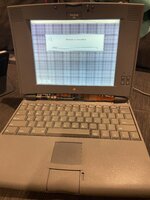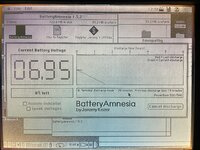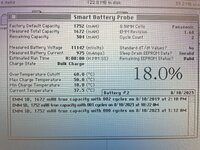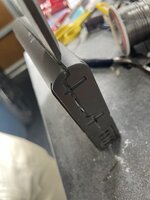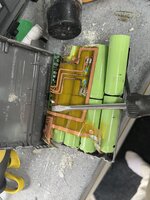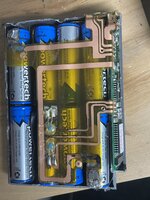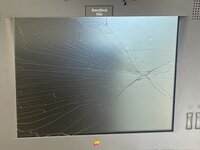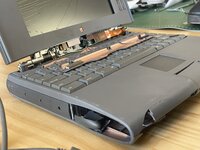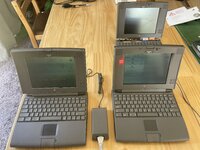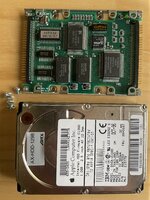Imitating the good-news post about the Powerbook 100, I couldn’t resist sharing a happy post about my 520 which arrived a week ago. I’d bought a power adapter previously - which was dead - but recapping it brought it to life.
The 520 came with two batteries both showing the usual corrosion; the terminals inside the Powerbook were also encrusted with blue crystals, which I managed to remove with vinegar, leaving the terminals usable.
I opened the batteries using a chisel, working my way around the edges and then carefully prying the area behind the PCB from the cell side using a screwdriver.
I’d bought 4/3AA 1500mAh cells in readiness but these are the wrong size - too small in diameter and too short. I built a battery pack anyway and - long story short - the PCB seemed to be faulty and didn’t measure the current, so didn’t charge correctly. With the other PCB, the battery ran the machine for about half an hour and reported a capacity of 438mAh - not too impressive, but a good start.
I rebuilt the pack again with tabbed AA cells (2000mAh) bought locally ($$$) and got a much better result where the machine ran for more than an hour and half with the hard drive in constant use and screen full-brightness I wonder if other people here get even more? I’m happy with that.
I wonder if other people here get even more? I’m happy with that.
Both the EMMPathy and Lind utilities tell me the battery memory is corrupted and can’t be repaired, but either will reset the battery and it seems to work anyway. Both batteries were previously showing cycle count around 100 and factory capacity just over 2000mAh. After the reset, they show a factory capacity of 1752mAh.
I found the EMMPathy Smart Probe the most useful to see what’s going on. After rebuilding with the tabbed cells, the current measurement was not working (showing -13mA even when charging) and the voltage would jump from 9.5V to 16.3V and back again. This turned out to be poor connectivity between the corroded copper ribbon and the cells. I bypassed it with wire and the current/voltage sensing is correct now. Actual capacity was measured at 1672mAh after the first full discharge. Charge current is 975-988mA.
The 520 came with two batteries both showing the usual corrosion; the terminals inside the Powerbook were also encrusted with blue crystals, which I managed to remove with vinegar, leaving the terminals usable.
I opened the batteries using a chisel, working my way around the edges and then carefully prying the area behind the PCB from the cell side using a screwdriver.
I’d bought 4/3AA 1500mAh cells in readiness but these are the wrong size - too small in diameter and too short. I built a battery pack anyway and - long story short - the PCB seemed to be faulty and didn’t measure the current, so didn’t charge correctly. With the other PCB, the battery ran the machine for about half an hour and reported a capacity of 438mAh - not too impressive, but a good start.
I rebuilt the pack again with tabbed AA cells (2000mAh) bought locally ($$$) and got a much better result where the machine ran for more than an hour and half with the hard drive in constant use and screen full-brightness
Both the EMMPathy and Lind utilities tell me the battery memory is corrupted and can’t be repaired, but either will reset the battery and it seems to work anyway. Both batteries were previously showing cycle count around 100 and factory capacity just over 2000mAh. After the reset, they show a factory capacity of 1752mAh.
I found the EMMPathy Smart Probe the most useful to see what’s going on. After rebuilding with the tabbed cells, the current measurement was not working (showing -13mA even when charging) and the voltage would jump from 9.5V to 16.3V and back again. This turned out to be poor connectivity between the corroded copper ribbon and the cells. I bypassed it with wire and the current/voltage sensing is correct now. Actual capacity was measured at 1672mAh after the first full discharge. Charge current is 975-988mA.

